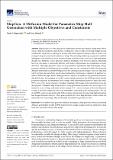| dc.contributor.author | Bagazinski, Noah J. | |
| dc.contributor.author | Ahmed, Faez | |
| dc.date.accessioned | 2023-12-22T15:48:51Z | |
| dc.date.available | 2023-12-22T15:48:51Z | |
| dc.date.issued | 2023-11-22 | |
| dc.identifier.uri | https://hdl.handle.net/1721.1/153238 | |
| dc.description.abstract | Ship design is a years-long process that requires balancing complex design trade-offs to create a ship that is efficient and effective. Finding new ways to improve the ship design process could lead to significant cost savings in the time and effort required to design a ship, as well as cost savings in the procurement and operation of a ship. One promising technology is generative artificial intelligence, which has been shown to reduce design cycle times and create novel, high-performing designs. In a literature review, generative artificial intelligence was shown to generate ship hulls; however, ship design is particularly difficult, as the hull of a ship requires the consideration of many objectives. This paper presents a study on the generation of parametric ship hull designs using a parametric diffusion model that considers multiple objectives and constraints for hulls. This denoising diffusion probabilistic model (DDPM) generates the tabular parametric design vectors of a ship hull, which are then constructed into a point cloud and mesh for performance evaluation. In addition to a tabular DDPM, this paper details adding guidance to improve the quality of the generated parametric ship hull designs. By leveraging a classifier to guide sample generation, the DDPM produced feasible parametric ship hulls that maintained the coverage of the initial training dataset of ship hulls with a 99.5% rate, a 149× improvement over random sampling of the design vector parameters across the design space. Parametric ship hulls produced using performance guidance saw an average 91.4% reduction in wave drag coefficients and an average 47.9× relative increase in the total displaced volume of the hulls compared to the mean performance of the hulls in the training dataset. The use of a DDPM to generate parametric ship hulls can reduce design times by generating high-performing hull designs for future analysis. These generated hulls have low drag and high volume, which can reduce the cost of operating a ship and increase its potential to generate revenue. | en_US |
| dc.publisher | Multidisciplinary Digital Publishing Institute | en_US |
| dc.relation.isversionof | http://dx.doi.org/10.3390/jmse11122215 | en_US |
| dc.rights | Creative Commons Attribution | en_US |
| dc.rights.uri | https://creativecommons.org/licenses/by/4.0/ | en_US |
| dc.source | Multidisciplinary Digital Publishing Institute | en_US |
| dc.title | ShipGen: A Diffusion Model for Parametric Ship Hull Generation with Multiple Objectives and Constraints | en_US |
| dc.type | Article | en_US |
| dc.identifier.citation | Journal of Marine Science and Engineering 11 (12): 2215 (2023) | en_US |
| dc.contributor.department | Massachusetts Institute of Technology. Department of Mechanical Engineering | |
| dc.eprint.version | Final published version | en_US |
| dc.type.uri | http://purl.org/eprint/type/JournalArticle | en_US |
| eprint.status | http://purl.org/eprint/status/PeerReviewed | en_US |
| dc.date.updated | 2023-12-22T13:45:07Z | |
| dspace.date.submission | 2023-12-22T13:45:07Z | |
| mit.license | PUBLISHER_CC | |
| mit.metadata.status | Authority Work and Publication Information Needed | en_US |
